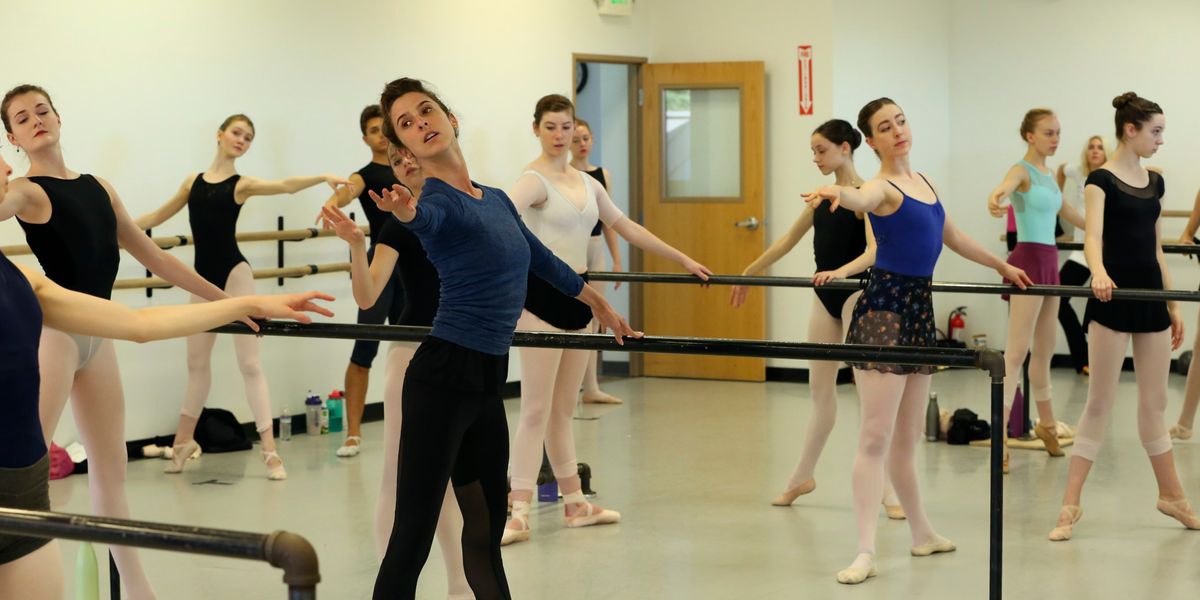The Teaching Side Hustle: How to Get Gigs and Feel More Comfortable at the Front of the Studio
After Ballet West first soloist Allison DeBona appeared on The CW’s “Breaking Pointe,” studio directors nationwide started calling her up, inviting her to teach master classes. Soon DeBona was traveling every month out of the year, honing her passion for coaching the next generation of artists.
While jet setting may not be in your future, regular teaching gigs are a great way to boost your resumé—and your income. Whether you’re looking for layoff-season work or want to branch into coaching and choreography, dipping your toe in the teaching world is a smart way to start.
 Ballet West principal Rex Tilton works with students at artÉmotion. Photo by Joshua Whitehead, Courtesy Ballet West.
Ballet West principal Rex Tilton works with students at artÉmotion. Photo by Joshua Whitehead, Courtesy Ballet West.
Getting Started
Few of us have a small-screen platform like DeBona, but you likely already have a network in place. Key contacts might be a teacher friend in need of a sub, the studio owner in your hometown or even your company’s academy director.
Whoever it is, you won’t get gigs without expressing interest. Nashville Ballet’s Mollie Sansone built her studio clientele by good old-fashioned cold calling. “I looked up all the dance studios in Nashville, wrote the numbers down and called around,” she says. If directors aren’t looking to hire, offer to put your name on a substitutes list. This can help you play the long game for future staff openings, and you might even prefer the flexible, ad-hoc work.
Be sure to leverage social media, too. DeBona turned her on-screen popularity into real-world opportunity by being accessible and open to online invitations. She now leads her own summer intensive, artÉmotion, during layoffs and publishes videos of the creative workshops on social media.
Sansone maintains her teaching presence with simple Facebook posts explaining “these are my credentials, this is what I do, this what I charge.” Here, you can slip in some target marketing. Offer pointe workshops, jazz or improvisation classes if they’re in your skill set, even private lessons. Sansone teaches both pre-professional ballet students at the School of Nashville Ballet and competition dancers at local studios. She acts as a coach, adding ballet’s finesse to their competition solos, duets and trios—a service parents are willing to pay for.
It might seem intimidating to speak in front of a roomful of expectant faces if you’ve never taught a class before. American Ballet Theatre soloist Craig Salstein, who started leading ABT company class while he was still a corps member, says that teaching can be learned even if you’re not a naturally outspoken leader. “You’re not going to tell someone how to do 135 pirouettes. Start with demi-pliés.” Sansone agrees that it’s not always about being some austere authority figure: “I’m goofy. I make fun of myself. If you get rid of the stoic persona, it’s so much easier.”
 Mollie Sansone in Nashville Ballet’s “Nutcracker.” Photo by Karyn Photography, Courtesy Nashville Ballet.
Mollie Sansone in Nashville Ballet’s “Nutcracker.” Photo by Karyn Photography, Courtesy Nashville Ballet.
Back to Basics
You may or may not find it useful to plan out each class combination. DeBona has an idea of what steps she will give but reevaluates during class when needed. “I want to address problems that are happening in the room rather than be married to a particular combination that I made up in my shower.”
If you have trouble coming up with combinations on the spot, try using a ballet class CD as a planning tool. Track names often suggest combinations that go with a certain style and meter (for example, “Waltz, 3/4, Pirouettes”). When creating combinations, start with steps that couple well together: piqué to failli, tombé to pas de bourrée, relevé prep to pirouette. Layer in challenges with repetition or double turns, or simplify by breaking down each couplet before linking them together.
Even for advanced dancers, you don’t need wildly inventive combinations. “Between ages 12 and 20 bodies are still growing,” Salstein says. “If you give something that’s too fast or complicated, that will frustrate students.” All levels can benefit from simplicity. Adult beginners are still learning the terminology, and Salstein says that even professionals would rather hone the fundamentals during class than worry about what comes next.
 Craig Salstein in American Ballet Theatre’s performance of “Romeo and Juliet.” Photo by Rosalie O’Connor, Courtesy ABT.
Craig Salstein in American Ballet Theatre’s performance of “Romeo and Juliet.” Photo by Rosalie O’Connor, Courtesy ABT.
Pace Yourself
For Salstein, time management is also crucial. “A teacher can’t say, ‘I’m sorry we didn’t get to big jumps.’ ” If you’re having trouble fitting it all in, he says, cut out the talking. Corrections can be simple: “I just remind people that it’s better to be lifted than dropped, better to have use of the upper body.”
That being said, Salstein would advise against nitpicking. Of course, technique is important both for aesthetic reasons and for the safety and health of your students’ bodies. But when you spend too much time harping on precisely placed tombé to pas de bourrées, he says, you’ll never get to glissade saut de chat. Doing so trains dancers to be uptight rather than physically in charge of their bodies and space.
When in doubt, err on the side of slow and simple, and give a class that you’d enjoy. Choose elements you like from your own teachers, and pass along what makes you show up in the studio every day. “Ballet can be fun, it can have movement,” says Salstein. “Make them fall in love with taking class.”
Additional Tips
- Since supplemental income is likely a motivator for your teaching gigs, don’t be afraid to talk about money. Nashville Ballet dancer Mollie Sansone averages between $30 and $40 per hour and negotiates higher for private lessons.
- If possible, watch a group of dancers for style and skill level before teaching them. If you can’t observe a class first, ask what to expect.
- l Be mindful about taking on too much. Make sure you have nights off, and remember your priorities. Ballet West first soloist Allison DeBona took a step back when she (and others) noticed that she sometimes came to work distracted or exhausted. Now she remembers, “I’m a dancer first.”






